Development and Validation of an RP-HPLC Method for Estimation of Secnidazole and Its Degradation Products in Tablets-Juniper Publishers
JUNIPER PUBLISHERS-OPEN ACCESS GLOBAL JOURNAL OF PHARMACY &
PHARMACEUTICAL SCIENCES
A simple, precise, specific, sensitive and accurate stability indicating RP-HPLC method for determination of secnidazole and its degradation products in tablets. The separation was performed on teknokroma, tracer excel C18 column (25cm x 0.46cm.5μm) using mobile phase consisting of water: methanol: acetonitrile in ratio (73: 17: 10). A flow rate was set at 1mL/min; the detection wavelength was set at 228nm. The calibration curves were found to be linear in the concentration range of 50-150/mL (r2 =0.9997) and 0.25-7.5μg/mL (r2 =0.998) at assay level and low-level of secnidazole. The percentage recoveries of secnidazole were 100.76-101.66% and 97.87-102% at assay and low-level, respectively at 95% confidence limit. The intraday precision was 0.553% and 1.35% at assay level and low-level, respectively. The intermediate precision was 0.56% and 3.10% at assay level and low-level, respectively.
Introduction
Secnidazole is chemically designated as (RS)-1-(2-methyl-5-nitroimidazole-1-yl) propan-2-ol.
It is a long-lasting nitroimidazole antimicrobial agent and used in treatment of amoebiasis, giardiasis and trichomonasis. Secnidazole is given by mouth, as a single dose of 2gm in adult or 30mg/kg in children. Spectrophotometric methods have been described for determination of secnidazole [1-4]. A HPLC method has been described for determination of secnidazole [5-17]. In the B.P and USP pharmacopoeias the methods for determination of secnidazole are not available, but in India Pharmacopoeia are available by using buffer. In the proposed method the analysis was performed without buffer.
Experimental
Instrumentation
An HPLC system from shimadzu corporation consisting of an LC-20 AT pump, SPD-20 A UV/vis-detector, DGU 20A3, a reodyne injector with 20μL loop. Teknokroma, tracer excel. C18 column (25cm x 0.46cm,μm).
Reference substances, reagents and chemicals
Secnidazole was obtained from globalpharma (Yemen). Monobasic potassium phosphate was obtained from fluka (Swistzerland). Methanol HPL grade and acetonitrile HPLC grade were obtained from sigma-aldrich (Germany). Water was obtained from arium-sartorius water purified system (Germany).
Standard preparation an accurately weighed 50mg secnidazole working standard was transferred into a 100mL volumetric flask and dissolved in mobile phase. The solution was completed to volume with mobile phase 4mL was transferred to 20mL volumetris flask and diluted to volume. Twenty μLsolutions were injected.
Sample preparation twenty tablet were weighed and powdered. Powdered tablet equivalent to 50mg secnidazole was weighed and transferred into a 100mL volumetric flask and the sample was diluted with mobile phase up to 70mL and sonicated for 10 minutes. The solution was completed to volume with mobile phase and filtered. A 4mL of filtrate was transferred into 20mL volumetric flask and diluted into the volume with mobile phase.
Related Substances
• Sample preparation
Powdered tablet equivalent to 50mg secnidazole was weighed and transferred into a 100mL volumetric flask and dispersed in 100mL of mobile phase filtered and 20 μL of filtrate was injected.
• Standard preparation
A 0.0005% w/v solution was prepared in mobile phase and 20 μL were injected.
In the chromatogram obtained with sample preparation, the area of any secondary peak is not more than the area of the peak in the chromatogram obtained with standard preparation (1/0 percent) and the sum of areas of all the secondary peaks is not more than 2.0 times the area of the peak in the chromatogram obtained with the standard preparation (1.P)
Chromatographic conditions
Twenty micro liters of standard sample solutions were injected into C18 column (5 μm ,250×4.6mm l.d). The mobile phase was water: methanol: acetonitrile in ratios 74: 15:10(v/v). The flow rate was 1mL/min the wavelength was at 228nm, the run time was 15 minutes.
Determination of linearity for assay of secnidazole Different aliquots of stock standard solution (0.5mg/mL) were transferred into a series of volumetric flask, and diluted to the mark with mobile phase to obtain final concentrations of 50μg/mL , 70 μg/ mL , 100 μg/mL , 120 μg/mL and 150 μg/mL . Twenty μL was injected in triplicate of each level.
Determination of linearity at low-level of secnidazole for degradation products: Different aliquots of working standard solution (5μg/mL) were transferred into a series of volumetric flasks and diluted to the mark with mobile phase to obtain final concentrations of 0.25μg/mL , 1.25 μg/mL , 2.5 μg/mL , 3.75 μg/mL and 5 μg/mL . Twenty μL was injected in triplicate of each level.
Determination of accuracy for assay of secnidazole
Accuracy was performed on 500mg/ tablet Accurate weight of secnidazole (25, 35, 50, 65, and 75 mg) were introduced into five volumetric flask (100mL), placebo (44.8mg) was added to each flask, dissolved and completed to volume with mobile phase (spiked placebo solution). An aliquot (4mL) each spiked placebo solutions was transferred into different (20mL) volumetric flasks and diluted to the mark with mobile phase to obtain concentrations of 50μg/mL , 70 μg/mL , 100 μg/mL , 130 μg/mL and 150μg/mL . The final solution was filtered through syring filter (0.45μm). Twenty μL was injected. Three triplicates were prepared for each level. The percent recovery was determined by an external standard at 100% level (100 μg/ mL).
Determination of accuracy at low-level of secnidazole
Different aliquots of standard solution (5μg/mL) were transferred into a series of volumetric flask; placebo (44.8mg) was added to each volumetric flask and diluted with mobile phase to volume to obtain final concentrations of 0.12μg/ mL, 1.24μg/mL, 1.2μg/mL, 2.4μg/mL and 7.2μg/mL. Three replicates were prepared for each level. The final solution was filtered through syring filter (0.45μm). Twenty μL was injected. The percent recovery was determined by standard solution at 1% (5μg/mL).
Determination of repeatability precision for assay of secnidazole
Spiked placebo solution was prepared by transferring 50mg of secnidazole and placebo (44.8mg) into (100mL) volumetric flask and diluted to the mark with mobile phase. Four mL of spiked placebo solution was transferred into a (20mL) volumetric flask and diluted with mobile phase to the volume (0.1mg/mL). The final solution was filtered through syringe filter (0.45μm). Twenty μL was injected. Six replicate spiked placebo solutions were prepared and two injections were injected of each sample.
Determination of intermediate precision for assay of prednisolone
Intermediate precision was performed such as repeatability procedure on different days and different preparations.
Determination of repeatability precision for degradation products at low-level of secnidazole
An accurately measured aliquot (1mL) of stock standard solution (0.5mg/mL) was transferred into a 100mL volumetric flask , placebo (44.8mg) was added the volumetric flask and diluted with mobile phase to volume to obtain final concentration of 5μg/mL The final solution was filtered through syringe filter (0.45μm). Twenty μL was injected. Six replicate spiked placebo solutions (5μg/mL) were prepared and two injections were injected of each sample.
Determination of intermediate precision for degradation products at low-level of secnidazolee
Intermediate precision was performed such as repeatability, procedure (low-level) on different day, and different preparation.
Determination of limit of detection (LOD) and limit of quantitation (LOQ) Different aliquots of standard solution were transferred into a series of volumetric flasks and diluted to obtain final concentrations of 0.025μg/mL , 0.05 μg/mL and 0.1 μg/mL and 0.25 μg/mL . Twenty μL was injected.
Forced degradation
Acid degradation
Two accurately measure aliquots (2X4mL) of stock solution (0.5mg/mL) were transferred into two separate (20mL) volumetric flask , placebo (44.8mg) was then transferred into one volumetric flask and 5mL of 0.1N HCl was added to each flask . The two solutions were stored for 3day at room temperature and exposed to 90oC for 8hours and then neutralized with 5mL 0.1N NaOH and diluted to volume with mobile phase . Twenty μL was injected.
Base degradation
Two accurately measure aliquots (2X4mL) of stock solution (0.5mg/mL) were transferred into two (20mL) separate volumetric flask , placebo (44.8mg) was transferred into one V.F. and 5mL of 0.1N NaOH was added to each V.F. . The two flasks were stored at room temperature for 1day and neutralized with 5mL of 0.1N HCl. The two flasks were diluted to the mark with mobile phase. Twenty μL was injected.
Hydrogen peroxide
Two accurately measure aliquots (2X4mL) of stock solution (0.5mg/mL) were transferred into two (20m) volumetric flask (V.F.) placebo (44.8mg) was added to one flask and then 5mL of 3.0% H2O2 was added to each flask and stored at room temperature for 5days and then diluted to the mark with mobile phase . Twenty μL was injected.
Light degradation
Two accurately measure aliquots (2X4mL) of stock solution (0.5mg/mL) were transferred into two (20mL) volumetric flask, placebo (44.8mg) was added to one V.F. The two V.F. were exposed to sunlight for 24hours. Twenty μL was injected.
Heat degradation
Two accurately measure aliquots (2X4mL) of stock solution were transferred into two (20mL) volumetric flask , placebo (44.8mg) was added to one V.F. and 10mL distillated water was added to each V.F. . The two V.F. were stored at 90oC for 1dsay and diluted with mobile phase to the mark. Twenty μL was injected.
Determination of robustness for assay
An assay standard solution was prepared and analyzed as test analytical method
- Mobile phase variation
- Methanol (17%) was varied by ±10%
- Acetonitrile (10%) was varied by ±10%
- The flow rate (1mL/min) was varied by ±10% .
- The column temperature ambient was varied by ±5oC .
- The system suitability standard solution was prepared and injected twice.
Determination of solution stability
- Fresh standard and spiked placebo were prepared and analyzed as per the test method.
- Time zero value for each was established.
- An aliquot of each solution was placed in clear glassware and exposed to ambient conditions and aliquot was placed in a refrigerator.
- The solutions were analyzed every 24hours for at least 48hours.
- Two injections were injected of each solution.
Result and Discussion
The mobile phase was chosen after several trials with different solvents in various proportions to reach a suitable mobile phase optimization. These trials include using different mobile phase consisting of methanol in water in different ratios. For 50% methanol, the retention time was 5.2 minute for secidazole and metronidazole and tinidazole was 4.1, which were overlapped. For 30% methanol, there was complete separation between metronidazole, tinidazole and secnidazole, the retention times were 6.6, 7.76 and 10.7 respectively. The standard solution of secnidazole was exposed to light and injected, the retention times were 5.1 and 10.78 minutes for 1-methyl-5-nitroimidazole, secnidazole respectively and 11.5min for isosecnidazole. The 30% methanol was published [1].
The organic solvent was changed to 15% THF which was estimated by solvent-monograph based on the 30% methanol, the retention times was 9.08 minute for secnidazole but the peak of 1-methyl-5-nitraimidazole was eluted at baseline disturbance. The organic solvent was changed to 20% ACN, which was estimated by solvent-monograph based on the 30% methanol but this ratio was published [7]. Therefore, organic solvent mixture was tried, mobile phase was prepared by blending equal volume of 30% methanol and 20% ACN, retention times were 5.6, 13.2, and 14.3 for 1-methyl-5-nitrimidazole, secnidazole and isosecnidazole respectively.
The most suitable mobile phase was found to be watermethanol- acetonitrile in ratio (73:17:10) as it showed a good separation as show in Figure 1 shown that, the retention times were and 10.94 and 11.71 for secnidazole and isosecnidazole, respectively. A mixture of metronidazole, tinidazole secnidazole was injected; the retention times were 7.16, 10.79 and 11.4 for metronidazole, tinidazole and secnidazole respectively (Figure 2). In Figure 3 in appendix III shown that, for 15% ACN, the retention times was 9.09, 15.65 and 19.3 for metronidazole, secnidazole and tinidazole respectively.
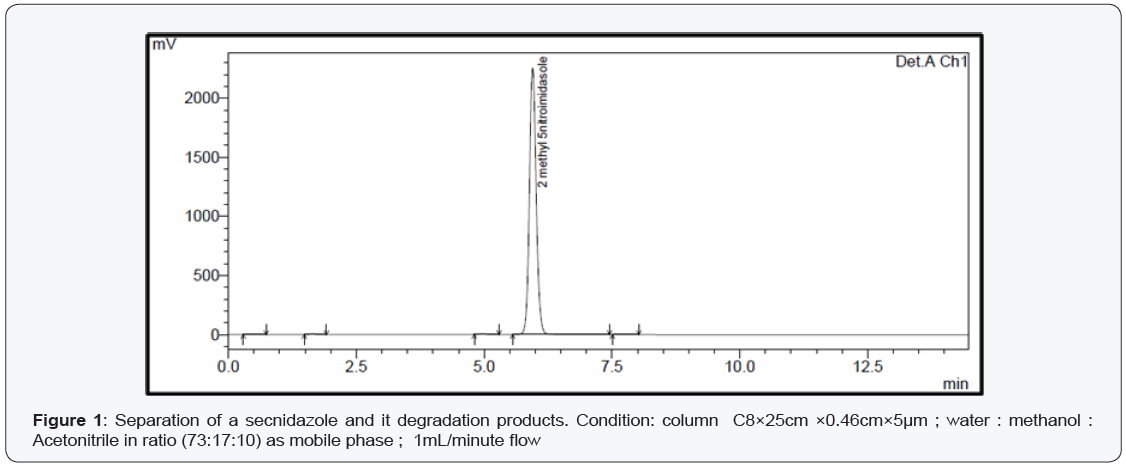
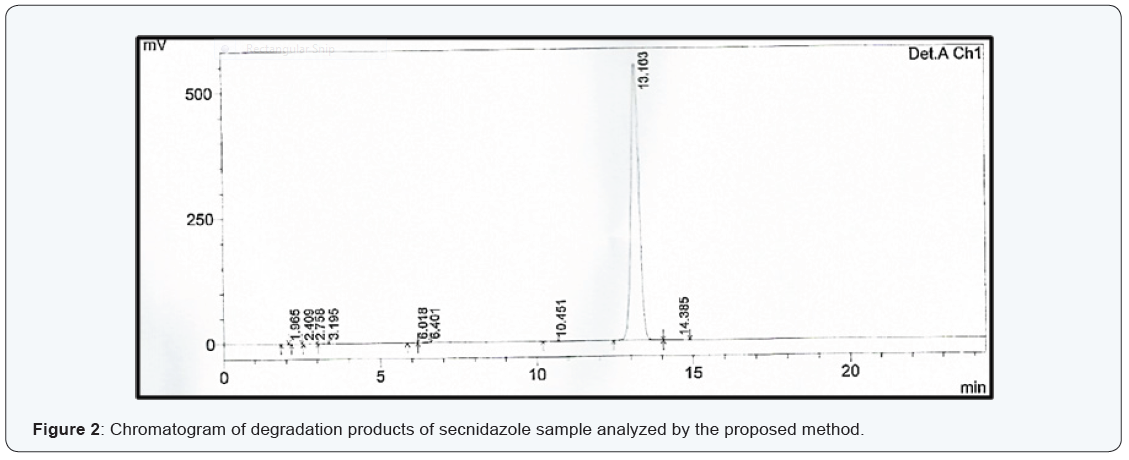
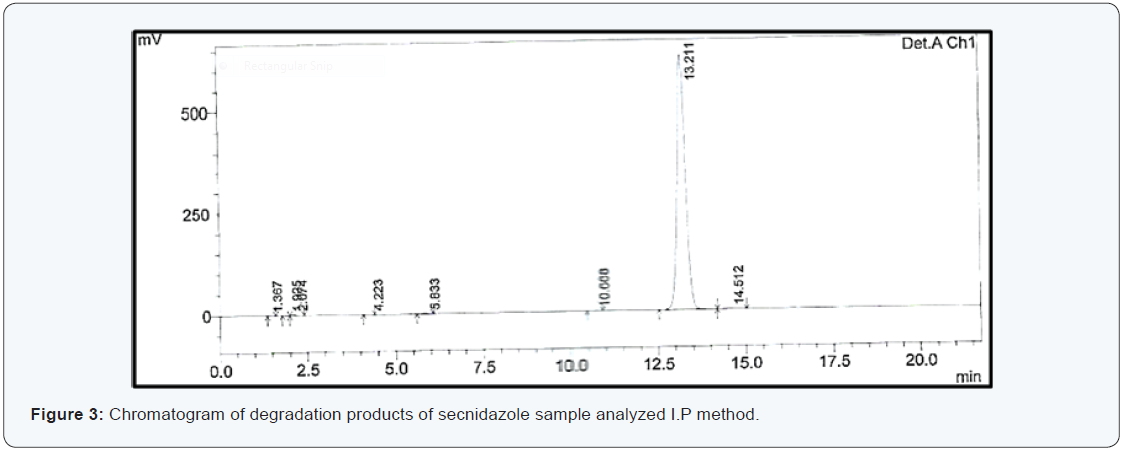
In an acetonitrile eluent was employed. The secnidazole was eluted prior to tinidazole. However, when a methanol eluent was used the reversal in elution order was obtained between secnidazole and tinidazole, tinidazole was eluted prior to secnidazole. Kazakevich reported that, “this can be attributed to the differences of the analytes interaction with the stationary phase and the adsorbed organic layer on top of the collapsed bonded phase. It has been shown that acetonitrile forms multilayer adsorption on top of the bonded phase, while methanol only shows monomolecular adsorption. In ACN, the retention mechanism involves a combination of analyte distribution between the eluent and an ACN, followed by analyte adsorption on the surface of the bonded phase. However, in methanol eluent the retention mechanism is predominately driven by an absorption type mechanism because the methanol adsorb in a form of a monomolecular layer. Hence, due to the difference in the analyte partition coefficients and their adsorption on the stationary phase, changes in selectivity could be obtained for two component when using either methanol/ water or acetonitrile water eluents” [18].
The standard and sample solutions of secnidazole were exposed to acidic, basic, oxidative, light and heat conditions. The degradation products that were generated from forced degradation were resolved from secnidazole peak. Secnidazole was found to degrade significantly in alkaline and oxidative conditions. Mild degradation of the secnidazole was occurred in acidic and light conditions. The drug was stable to heat. The loss of secnidazole was a corresponding to increase in the level of degradation studies was indicated that, the RP-HPLC method was stability-indicating for analysis the secnidazole and its degradants as shown in Table 1.


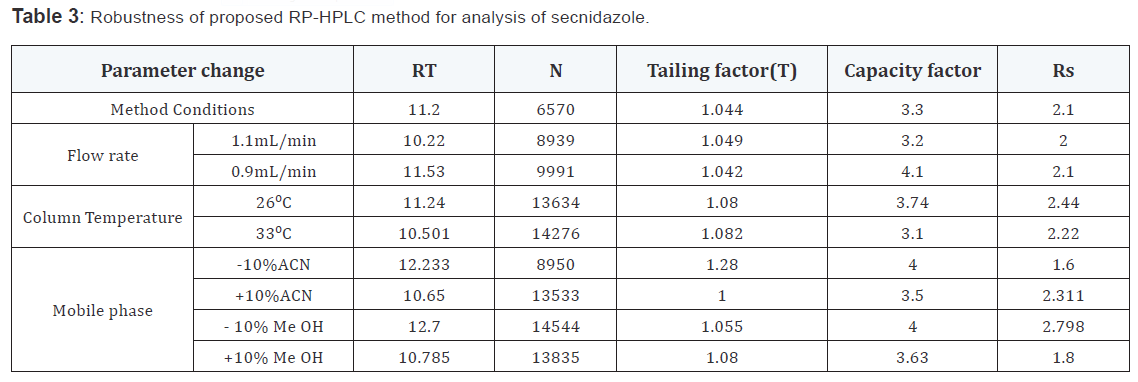
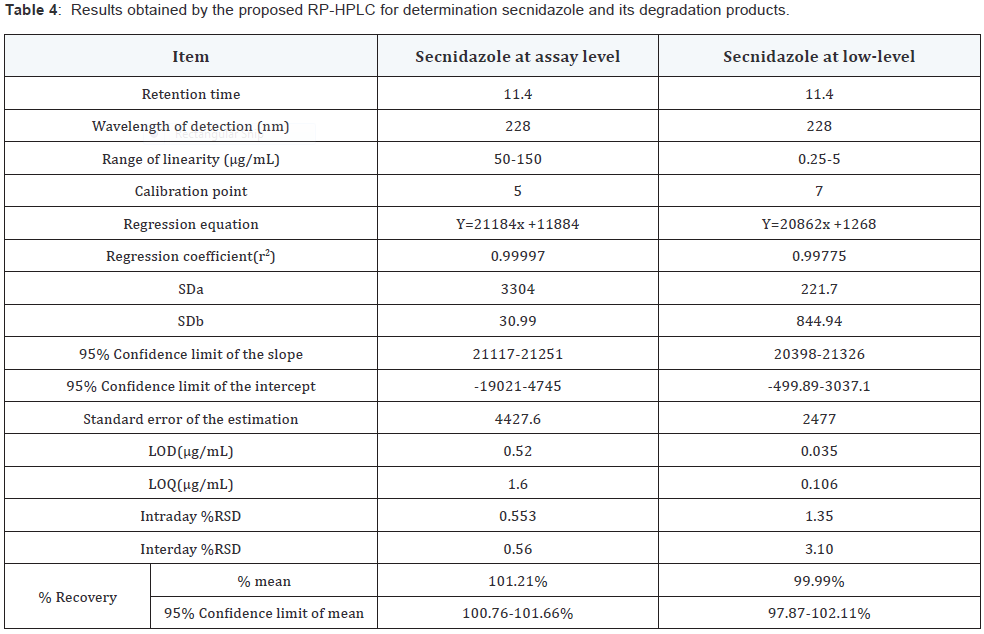
Robustness of the method to small but deliberate changes was evaluated with a designed study including two levels (high and low) and three factors: temperature (±5oC) flow rate (±10%), methanol (±10%) and acetonitrile (±10%). The parameters were within the system suitable parameters as shown in Table 2 and in Table 3. Standard and sample solutions were shown to be stable for 48 hours at room temperature. The results in Table 4 shown that, the intraday precisions were 0.553% and 1.35% at assay and low-level respectively. The interday precisions were 0.56 and 3.10% at assay and low-level, respectively.
The results for the evaluation the linearity of secnidazole at assay level were given in Table 4 shown that the correlation coefficient of 0.999972 which was acceptable –the slope was 21184 and the Y-intercept was 11884. The regression equation for the graph was computed and found to be: y=21184x +11884→(1) , where x is concentration in μg/mL . The regression statistics was performed by Excel and SPSS, the Y-intercept was 0.56% compared to the calculated Y-value at 100% standard (100μg/mL) and the acceptance criteria was ≤2.0%. The residual standard deviation was 0.21% (standard error compared to calculate Y-value at 100% level) and acceptance criteria were ≤2.0%.
These results clearly demonstrate a linear relationship between the peak areas and the concentrations of secnidazole in the ranges of 50μg/mL to 150μg/mL. The results for the evaluation of the linearity of secnidazole at low-level were given in Table 4 shown that, the correlation coefficient was 0.998 and which was acceptable .The slope was 20862 and intercept was 12686 the regression equation for the graph was computed and found to be : y=20862x + 12686→(2) , where x is the concentration at low-level. The regression statistics were performed by excel. Y-intercept value was 1.2% and acceptance criteria of ≤5% based on 1% level (5μg/mL). The residual standard deviation was 2.33% and the acceptance criterion of 10%.
The results clearly demonstrate a linearity relationship between the peak areas and the concentrations of the range of 0.25μg/mL to 7.5μg/mL. The difference in slope of upper range and slope of lower range in linearity curves was 1.0154% and the acceptance criterion of ≤4.0%. Therefore, the 100% standard or area percent normalization could be used to quantitate the levels of degradation products. The results in Table 4 shown that the percent recovery for assay of secnidazole was inside of 100±2% limit for the average of each level. Each individual sample recovery was inside of 98-102% limit. The recovery of the RP-HPLC method for the assay of CFA was demonstrated by a mean of 101.21%. The results in Table 4 shown that, the recovery of the individual and average of each degradand level was within the range of 75% - 125% at each concentration level. The lowest level (LOD) with a signal-to-noise ratio greater than or equal to three was determined to be 0.005% (0.025μg/mL) to the concentration of 0.5mg/mL for related substance. The lowest limit of quantitation (LOQ) was determined to be 0.05% (0.25μg/mL) to the concentration of 0.5mg/mL for related substances.
Statistical comparison between the assay results obtained by the proposed RP-HPLC method and reference method (I.P 2007) showed no significant difference as shown in Table 5. The assay result of the proposed method was 99.78 inside the recovery limit (100±2%) where the assay results of I.P method were 101.26%. Therefore, no significance difference between two method concerning accuracy but there was statistical significance difference in, in the precision where the calculated F test was more than tabulated F test but the proposed method was more precision than the (I.P) methods. Statistical comparison between the results of degradants of secnidazole table was obtained by the proposed method and the reference method [19-20].
In the chromatogram obtained with test solution (0.5mg/ mL) the area of any secondary peak is not more than the area of peak in the chromatogram obtained with reference solution (0.005mg/mL) (1%) and the sun of areas of all the secondary peak is not more than 2 times (2%) the area of the peak in the chromatogram obtained with reference solution (0.005mg/ mL)(2%) [19]. the results in Table 6 shown that, the individual area did not exceed 1% in both method. there was no significant difference between two method for determination degradants (2-methyl-5- nitroimidazol ) and unknown 1 but there was statistical significant difference between the two method for determination of isosecnidazole but practical no significant difference because the recovery of the proposed method was inside 75-125% limit. There was no significance between the two methods in the variations as shown in Table 6. Practical no significant difference in the accuracy and precision. There was no significant difference between the two methods.
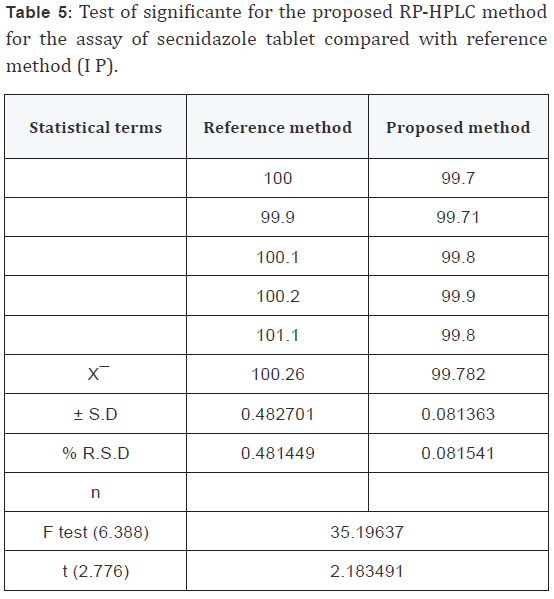

Practically no significant difference between the two methods. Based on results obtained it found that the proposed method is accurate, precise, reproducible, rapid and economic and can be used in routine analysis of raw material and table.
Conclusion
- The proposed method was found to be linear at assay level of secnidazole in the range of 50μ/mL to 150μ/ mL and linear at low-level of secnidazole in the range of 0.25μg/mL to 0.5μg/mL.
- The proposed method was found to be precise, intermediate precise and accurate at assay level of secnidazole and at low-level of secnidazole.
- All degradation products formed during forced degradation studies were well separated from the secnidazole peaks and the degradation products were separated from each other, demonstrating that the proposed method was specific and stability-indicating.
- The new method was shown to be robust.
- The standard solution and sample solutions were stable for 48 hours at room temperature.
- The 100% standard or sample solution could be used to quantitate the % levels of degradation products of prednisolone.
- Test significance for the result obtained by the proposed method compared to the reference method. The test was ascertained that the new method was precise and accurate as the reference method.
- Test of significance for the results obtained by the new method for determination of % level of degradation products compared to the reference there were no significant difference at 5% level.
- The LOD and LOQ were found to be 0.025μg/mL 0.25μg/mL, respectively.
- The assay and degradation products of secndazole in tablet were determined by single method.
- The RP-HPLC proposed method can be used in routine analysis and quality control of secnidazole in tablets.
- The RP-HPLC proposed method can be used in stability study of secnidazole in tablets.
For more Open Access Journals in Juniper Publishers please
click on: https://juniperpublishers.com
For more articles in Global Journal of Pharmacy
& Pharmaceutical Sciences please click on: https://juniperpublishers.com/gjpps/index.php
For more Open
Access Journals please click on: https://juniperpublishers.com



Comments
Post a Comment